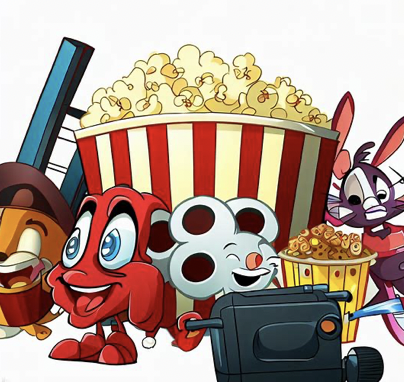The font for movie credits used can play a role in setting the tone and enhancing the overall cinematic experience.
The right font choice can evoke emotions, convey the film’s genre, and leave a lasting impression on the audience.
Movie Credits Font
- Univers: Often used for its clean, modern appearance and readability.
- Helvetica: A popular choice for its neutral and clear typeface.
- Franklin Gothic: Frequently used for its bold and attention-grabbing style.
- Futura: Known for its geometric shapes, it gives a modern and minimalistic look.
- Garamond: Sometimes used for a more traditional and elegant feel.
- Bebas Neue: A tall, bold typeface often used for emphasis and impact.
- Arial: A standard, easy-to-read font used in various contexts.
Below we look deeper into movie credits fonts – including some other semi-common choices – their importance, popular choices, and how they contribute to the storytelling process.
Table of Contents
Popular Movie Credits Fonts
There are numerous fonts available for movie credits, each with its own unique characteristics and style. Here are some popular choices:
1. Helvetica
Helvetica is a timeless and versatile font that is widely used in various design applications, including movie credits.
Its clean and simple design makes it highly readable, while its neutrality allows it to adapt to different film genres and styles.
2. Futura
Futura is a geometric sans-serif font that exudes a modern and futuristic vibe.
It is often used in science fiction and action films to convey a sense of technological advancement and sleekness.
3. Trajan
Trajan is a classic serif font that is commonly associated with historical and epic films.
Its elegant and majestic appearance adds a touch of grandeur to movie credits, making it a popular choice for period dramas and historical documentaries.
4. Gotham
Gotham is a contemporary sans-serif font known for its clean lines and versatility.
It has been used in various blockbuster films, including “The Dark Knight” and “The Avengers,” to create a modern and sophisticated look.
5. Copperplate Gothic
Copperplate Gothic is a bold and distinctive font that adds a touch of elegance and formality to movie credits. It is often used in films that require a more traditional and refined aesthetic.
Case Studies: Font Impact on Movie Credits
Let’s take a closer look at two case studies that highlight the impact of font choice on movie credits:
Case Study 1: “The Great Gatsby” (2013)
In Baz Luhrmann’s adaptation of F. Scott Fitzgerald’s “The Great Gatsby,” the movie credits font played a crucial role in capturing the essence of the Roaring Twenties.
The font used, Deco Pinstripe, was inspired by the Art Deco movement of the era.
Its sleek and ornate design perfectly complemented the film’s lavish and extravagant visual style, immersing the audience in the glitz and glamour of the time.
Case Study 2: “The Social Network” (2010)
David Fincher’s “The Social Network” tells the story of the creation of Facebook and the ensuing legal battles.
The movie credits font, Klavika, was chosen to reflect the film’s theme of technology and innovation.
Klavika’s clean and modern design aligned with the film’s portrayal of the digital age, reinforcing the narrative and enhancing the overall viewing experience.
The Importance of Movie Credits Font
Movie credits are more than just a list of names scrolling across the screen at the end of a film.
They serve as a powerful tool for filmmakers to acknowledge the contributions of the cast and crew, create a sense of closure, and leave a lasting impression on the audience.
The font used in movie credits can significantly impact how these objectives are achieved.
Here are some key reasons why movie credits font is important:
- Branding: The font choice in movie credits can reinforce the film’s branding and visual identity. It can align with the film’s genre, style, and overall aesthetic, creating a cohesive experience for the audience.
- Emotional Impact: Different fonts evoke different emotions. A bold and dramatic font can convey a sense of intensity, while a delicate and elegant font can create a more romantic or nostalgic atmosphere. The font choice can enhance the emotional impact of the film and leave a lasting impression on the viewers.
- Readability: Movie credits need to be easily readable to ensure that the audience can comfortably read and understand the names of the cast and crew. The font should strike a balance between style and legibility.
- Consistency: Consistency in font choice throughout the movie credits helps maintain a professional and polished look. It ensures that the audience can easily follow the information presented and avoids any distractions or confusion.
FAQs – Movie Credits Font
1. What is the purpose of movie credits?
Movie credits serve multiple purposes, including acknowledging the contributions of the cast and crew, creating closure for the audience, and providing essential information about the film.
2. How does the font choice impact movie credits?
The font choice in movie credits can impact the film’s branding, emotional impact, readability, and overall consistency.
It can reinforce the film’s genre, evoke specific emotions, ensure legibility, and maintain a professional look.
3. Are there any rules or guidelines for choosing a movie credits font?
While there are no strict rules, it is essential to consider factors such as the film’s genre, style, and target audience when choosing a movie credits font.
It should align with the overall aesthetic and effectively convey the intended message.
4. Can a font be copyrighted?
Fonts can be copyrighted, but it is important to note that copyright protection extends to the software or file containing the font, not the design of the letters themselves. Some fonts may also have specific licensing restrictions.
5. How can I ensure the readability of movie credits?
To ensure readability, it is crucial to choose a font that is legible even at smaller sizes. Avoid overly decorative or complex fonts that may hinder readability.
Additionally, consider factors such as contrast, spacing, and background color to enhance legibility.
6. Can I use multiple fonts in movie credits?
Using multiple fonts in movie credits can be visually appealing if done tastefully.
However, it is important to maintain consistency and ensure that the fonts complement each other and the overall design.
7. Are there any trends in movie credits fonts?
Movie credits fonts, like other design elements, can be influenced by trends.
Currently, there is a growing trend towards clean and minimalist fonts that prioritize legibility and simplicity.
8. Can I create my own movie credits font?
Yes, it is possible to create a custom movie credits font. However, it requires expertise in typography and font design.
Hiring a professional font designer or typographer is recommended for creating a unique and well-crafted font.
9. Are there any free movie credits fonts available?
Yes, there are several free movie credits fonts available for personal and commercial use.
Websites like Google Fonts and DaFont offer a wide range of fonts that can be used in movie credits.
10. How can I choose the right movie credits font for my film?
Choosing the right movie credits font involves considering the film’s genre, style, and target audience.
It is important to select a font that aligns with the film’s overall aesthetic and effectively conveys the intended message.
Experimenting with different fonts and seeking feedback from others can also be helpful in making the right choice.
Summary – Movie Credits Font
Movie credits font plays a crucial role in enhancing the overall cinematic experience.
The font choice can reinforce the film’s branding, evoke emotions, ensure readability, and maintain consistency.
Popular movie credits fonts include Helvetica, Futura, Trajan, Gotham, and Copperplate Gothic.
Case studies like “The Great Gatsby” and “The Social Network” demonstrate the impact of font choice on movie credits.
When choosing a movie credits font, it is important to consider factors such as the film’s genre, style, and target audience.
Experimentation and seeking feedback can help in making the right choice.


